Niazaey , the progenitor of Niazi tribe, was one of the three sons of Ibrahim alias Loedae (Lodi), son of Bibi Mato and Shah Hussian Ghori. Niazaey had three sons, Dzam, Bahi and Khaki/Khako. Dzam or Jamal had seven sons from three wives, namely Daulat, Isa and Ali from first wife , Sumbal and Pindar (or Pandar) from the second wife and Marhal or Jalaey from third wife. Isa is the progenitor of Isa Khels.[1]
Niazis initially occupied an area in the district Shilghar , situated to the south of Ghazni. When the Ghalzai became numerous, they drove the Niazis to the eastward and the Andar branch of the Ghilzais still hold Shilghar [2][3].
Niazis journeyed South untill they came until they came to the Tank. There they found rest and their young men became merchants and carriers.[4].
They subsequently spread farther to North-East , towards the Indus and dwelt in the sandy tracts of Thal. Mahyar, a branch of Niazis, sought help from the Marwat against its fellow Niazi Clan, Sarhang. The Marwat attacked the Niazis and in a severe battle near Tatti Michan Khel, the latter were completely defeated and pushed towards Isa Khel. Among them, only the Michan Khels were spared due to their neutrality and religious position”[5].
In cis-Indus area, the Niazis ousted the Khattars and apportioned the area. The Sumbals were the most powerful clan of the Niazis that assumed the leadership.[6]
In the late 14th century , Niazis along with other Matti tribes were militarily strong enough to catch the attention of Amir Timur. Niazis under their leader Malik Habib Niazi joined Timur’s invasion of India.[7] After the campaign Malik Habib Niazi returned to his country.In Hind , the Niazis formed their colonies and served the cause of their ruling Lodi kinsmen. According to Tarikh-i-Daudi, Sultan Bahlul Lodi left behind a will addressed to Nizam Khan (Sikander Lodi). The contents of the will are, “First do not appoint a member of Sur tribe as a Khan or an Amir because they are aspirants for royalty Second never appoint a Niazi to any office in the state because they are reckless in behavior and have no sense of loyalty”
Perhaps excluded all Niazis because his father had been killed in a war against them. It was during the period of Suri dynasty , that they came into limelight. Niazis rendered vital support to the Surs and were given positions of power. Haibat Khan Nizai was the most trusted officer of Sher Shah Suri. He and Isa Khan Niazi appear in the various episodes of Sher Shah’s struggle for power against Emperor Humayun.
In 1542 AD, Sher Shah left the charge of Punjab to Haibat Khan, Khawas Khan and some other chiefs of Kakars and Jalwanis. Haibat Khan Niazi commanded Sher Shah’s forces in the campaigns against the Gakhars in the North and the rising Baloch influence in the south. He captured Kashmir and installed the Chak dynasty there on behalf of Sher Shah Suri. The fortress of New Rohtas , near Jhelum, was founded during this period and Haibat Khan Nizai held it with a force of 30,000 Afghan cavalry all in his own pay, no other Pashtun chief could boast of such huge cavalry force or afforded such expenses.[8]
In 1543-44 ,differences arose between Haibat Khan Niazi and Khawas Khan, the latter informed Sher Shah of the rift through the letter. Sher Shah recalled Khawas Khan, Isa Khan Niazi and Habib Khan Kakar and transferred the government of Punjab to Haibat Khan to whom he gave the orders to wrest Multan from the sway of Balochs and detain Fateh Khan Jat of Kot Kaboola [9].
Haibat Khan , in obedience to the command, reached Songkehra. He sent Dhondana, the local chief, to Fateh Khan Baloch to induce him to mend his conduct. Meanwhile , he advanced up to the shrine of Shiekh farid Gunj Shakar. Fateh Khan Baloch shut himself in Fatehpur fort. Through the mediation of a nephew of Shiekh Farid, he came out to the besiegers. Haibat Khan put him in confinement till the arrival of fresh instructions from Sher Shah. Medu Baloch inspired by his strong attachment to the Baloch chief, tried to get Fateh Khan relaesed by force. He failed and surrended on the second day [10].
B.Dorn writes that Medu was seized by Bukhshoo Langah and delivered alive to Haibat Khan , who took possession of town of Multan and all its dependencies and made the strongest efforts to re-populate the country, which lay in a state of desolation by the oppressions of Balochs.
For his services , Haibat Khan Niazi was raised to the highest rank, with the title of ‘Masnad-i- Aali Azam Humayun’ – a title which had been conferred by the Afghan sovereigns on two previous occasions. He was likewise assigned a scarlet tent, which only the family of the sovereign was hitherto allowed to use.[11]
At this time Sher Shah nominated his nephew Mubarak khan, his brother’s son by a slave-girl, to the charge of the part of Roh which was in the Niazi’s possession. It so happened that a Sumbal freeholder named Allahdad had a daughter of unequaled beauty, whose good looks were the theme of general talk. ‘Her lashes’ arrow she had pulled on the bow of her eye-brows, her cheeks were a living flame, and her long tresses as the smoke that rises from the fire.’ Mubarik Khan saw her once only and became enamored of her. Forgetting the pride of race among the people of Roh, he dispatched a confidential messenger to Allahdad to ask his daughter’s hand in marriage.
Allahdad presented his duty to the governor, but answered with all respect that the Khan, holding as he did the authority, must have in his harem many noble ladies and beautiful slavegirls. Moreover the Khan, who had been brought up in Hind, possessed a refined taste, while his poor child was of a rustic temperament and had only the qualities of Roh. In short, the inequality between them was so great that a marriage could not be thought of. Mubarik, frustrated, turned to molest the Sumbal clan, thinking to force Allahdad’s hand. A jirga of three notables then waited upon him. While agreeing that there had been previous instances of alliances between Niazis and Sun, they observed that these had been between equal and equal, the free-born with the free-born, the slave with the slave, falcon with falcon, pigeon with pigeon. One of them had a daughter by a slave-girl, and the Khan could have her. Let him in any case refrain from oppressing the clan, Allahdad was free-born, and would never consent to the alliance proposed, even at cost of his life. But Mubarik, full of the pride of authority, refused to listen, and thinking to teach the clan a lesson, plundered one of the Sumbal villages and carried off a slave-girl. The Jirga of the whole tribe then proceeded in a body to his presence, protesting that the honour of their ‘women and dependents was to them the same as the honour of his to himself they requested him, still with respect, to give up the girl. But, getting only a sharp answer, they opened their minds and said, ‘You were born in Hind and know not the ways of the Afghans. Hitherto the heron has not dared to play the tyrant over the falcon. Out of respect for your uncle, the Shah, we have shown respect to you, the son of a bondwoman. Leave us alone, oppress us not, and let this woman go.’ ‘You prate of honour,’ replied Mubarik in a fury, ‘but I measure honour by the fulness of my house. I will keep this girl, and what is more, will take Allahdad’s daughter from him by force.’ The Maliks answered fiercely that if he valued his life, he would keep his eyes and hands off their women, where upon Mubarik ordered his men to drive them out with rods. Their anger roused, the tribesmen, though they had by custom left their weapons outside the audience chamber, fell on the governor with their bare bands, and killed him and every one of his attendants. When this got to Sher Shah’s ears, he wrote to Haibat Khan saying that the tribe of Sur, his own, was few in number.
If every other Afghan should slay a Sur, not one of them would be left. The Sumbals were of Haibat Khan’s own tribe; let him deal with them and punish them in such a way that others might not get into the bad habit of killing governors. Hearing of Haibat khan’s advance, Sumbals sought retreat in hills, determining to withdraw towards Kabul, for Sher Shah’s writ did not run so far. So, a Niazi himself he resorted to finesse. Pretending that, if they came in on safe-conduct he would arrange a composition and emphasizing that they could trust him as a fellow-tribesman, he induced nine hundred of them to come in with their families. The men he slaughtered and sent in the women to the presence of Sher Shah. The Niazis offered those of Sumbals who were related to them , an opportunity of escape , but they refused it and perished with their fellow tribesmen. The emperor disapproved most strongly, saying that, as between tribesmen, so base an act had never before been committed. ‘At least,’ be added, ‘Haibat Khan evidently nourishes no thoughts of sovereignty himself since he has slain so many of his own tribe; if he did, he could never have forgotten his Pashtu so far as to shed the blood of his people unjustly.’ On this Sher Shah meditated the removal of Haibat Khan from the Panjab, but shortly alter this event, in 1545, he died. He was killed by an accidental explosion of gunpowder at the siege of a fortress at Kalinjar in the Bundelkand hills south-west of Prayag.[12][13]
Islam Shah succeeded to the throne after the death of Sher Shah Suri. Though Sher Shahs eldest son, Adil Khan was nominated by him as his successor but the nobles preferred Jalal Khan, Sher Shahs younger son who was regarded more capable by them. Jalal Khan was called by them to come to Kalinjar and after his arrival, he was declared Sultan on 27 may 1545 A.D. He assumed the title of Islam Shah. Islam Shah could not feel secure as long as his elder brother was alive. He asked him to come to Agra. He was assured of his life and the grant of Jagir of Sayan. Eminent nobles like Isa Khan Niazi and Khawas Khan stood surety for his life. Adil Khan went to Agra, paid homage to the Sultan and returned to Bayana. Islam Shah tried to murder him but failed. Feeling insecure Adil Khan sought support of Khawas Khan. They combined their forces and proceeded towards Agra but the rebels were defeated. Adil Khan fled towards Panna and was heard of no more.
Khawas Khan also fled towards Sarhind. Islam Shah tried to kill ail those nobles who were supposed to be in sympathy with Adil Khan. Thirteen old nobles were sent to Gwalior where they were blown by gun-powder. Said Niazi fled away from the court and found shelter with his brother Haibat Khan Niazi, governor of Lahore. On account of his flight, Islam Shah went back to Agra, where he collected his troops and marched thence towards Dehli. When Shujé.’ Khan received intelligence of these occurrences, he hastened to Delhi with all possible speed, without being summoned by Islam Shah. The King gratified him by treating him with distinction, and after arranging his army, and halting some days at Dehli, he proceeded in the direction of Lahore. Haibat Khan and the whole of the King’s enemies had an interview with Khawas Khan and his friends, and dispatched a powerful force from the Panjab to encounter Islam Shah. They came up with each other near Ambala; and as Islam Shah was encamped very near the Niazi troops, a fight was imminent.
On the night preceding the day of battle, Haibat Khan and his brothers met in Khawas Khan’s tent, and consulted together concerning the appointment of another Sovereign. Khawas Khan said, that the best course would be to raise Adil Khan, the eldest son of Sher Shah, to the throne, as he was the rightful heir. Upon this all the Niazis said unanimously, ”What advice is this ? No one obtains a kingdom by inheritance ; it belongs to whoever can gain it by the sword.” Khawas Khan was vexed at their intentions, and on the same night he secretly sent a verbal message to one of the confidential servants of Islam Shah, requesting him to inform the King, that although His Majesty looked on him (Khawas Khan) as an unfaithful servant, yet that his heart had always inclined towards Sher Shah’s family and offspring; and that although he had sided with Adil Khan, who were the Niazis that he should be guilty of disloyalty to his benefactor on their account, and for the sake of their alliance ? That his wish to be of service should, with the consent of the Almighty, be made manifest on the day of battle. When Islam Shah became aware of the disagreement which had taken place amongst the chiefs of the enemy, and of the friendly feeling of Khawas Khan, he rejoiced exceedingly, and became confident of success. Meanwhile, news was brought that the Niazi troops had advanced to within a very short distance of the royal camp. Islam Shah said: ” The Afghans have no sense.” He made an enclosure with all his wheeled carriages, like a fortress, into which he caused the whole of his army to enter, and then went in person to reconnoiter the Niazis from an elevated position. When he beheld the foe, he said, ”I shall be disgraced if I do not fight the rebel troops,” and ordered the chains, with which the carriages were fastened together to be removed.
At that moment, he ranged his troops in battle array, and made ready for the fight. The war drums were beaten on both sides._ Khawas Khan sent to tell Haibat Khan and his brothers to advance when they saw him do so on his elephant with his standard displayed, and not to forsake him. With this intention they turned their faces towards the field. Khawas Khan started from his post, but attacked no one, and succeeded in making his way into the open country. The Niazis fought to the best of their ability, but as no benefit is ever derived from disloyalty, and as it always occasions distress and regret, they were routed, and the victory remained with Islam Shah. Whilst these events were occurring, Saeed Khan Niazi, the brother of Haibat Khan, came armed to the teeth, under the pretext of congratulating the King; hoping, as no one knew him, to find an opportunity of slaying Islam Shah. He mixed with the royal guards. Islam Shah was at the time standing surrounded by a circle of war elephants, and Said Khan was, consequently, unable to reach him immediately.
He was shortly afterwards recognized by one of the elephant drivers, who gave the alarm, and was slain by a thrust of Saeed’s spear. Saeed’s valour and strength enabled him to make good his escape from the place where the royal guards were. The Niazis fled to Dhan kot, which is near Roh [14]. After their defeat, they were hindered in their flight by the marshy ground in the neighborhood of Ambala, which prevented their horses from proceeding, and consequently Islam Shah’s troops who were in pursuit coming up with them, made a great slaughter of the Niazis. Islam Shah followed them in person as far as New Rohtas, and there appointed Khwaja Wais Sarwani, with an immense army, to prosecute the war with the Niazis, after which he turned back towards Agra and Gwalior.
Haibat khan Niazi and Khwaja Wais Sarwani fought together on several occasions. In the last action Haibat khan defeated the Khwaja, and Niazis pursued them as far as Sirhind. When Islam Shah heard this news, he raised a large force, and sent it against the Niazis, on which Haibat khan retraced his steps and went to Mankot. Islam Shah’s troops came up with him near Sambhal, and a battle took place, in which the Niazis, numbering 20,000 were again routed. Numbers of Niazi contigent women, falling into the hands of conquerors, were sent to Islam shah. The captured Niazis including women and children were brutally treated by Islam Shah. Some women were kept exposed for months in the state of nudity. Others were made over to harlots!. This dishonor of ladies was resented by Afghans in general, most of whom were in some way connected togather. The defeated Niazis couldn’t win the support of the Pashtun tribes settled along both banks of Indus. They took refuge with the Gakhars, in the hill-country bordering on Kashmir. Islam Shah advanced in person with a large army for the purpose of quelling the Niazi rebellion, and during the pace of two years was engaged in constant conflicts with the Ghakkars, whom he desired to subdue[15].
He strove by every means in his power to gain possession of the person of Sulta Adam Ghakkar, who had been a faithful friend of the Emperor Humayun, without success; but he caught Serang Sultan Ghakkar, who was one of the most noted men of his tribe, and caused him to be flayed alive, and confined his son, Kamal Khan, in the fort of Gwalior. When Islam Shah had thus taken a proper revenge of Sultan Adam Ghakkar, and destroyed many of his tribe, man of the zamindars whose possessions were at the foot of the hills submitted themselves to him. Skirting the hills. He then set seriously to work to exterminate the Niazis. When the Ghakhars had been rendered powerless, Haibat Khan went into the hill-country of Kashmir. Islam Shah encamped beneath Kaituli-shahr, and designed to pursue the Niazis into Kashmir; while Mirza Haidar, the Governor of Kashmir, in order to gain Islam Shah’s good-will, blocked up the road against the Niazis. Haibat khan perceived that the King was coming in his rear, and that the Governor of Kashmir had closed the path on ahead ; being, therefore, unable to effect anything, he went to Rajauri. Islam Shah ‘pursued the Niazis with the choicest of his troops as far as the village of Madad, in the territory of Naushahra on the Chenab river, where he was terrified by the dangers and difficulties of the mountain passes, and thought that his best plan would be to make peace.
With this view he sent Said Khan and Abdul Malik, who were two of his most trusted and confidential courtiers, with a letter to Haibat khan and the other Niazis, counseling them to take a course by which their interests would be best benefited. Haibat khan son and mother were then surrendered as hostages to Islam Shah. The latter, taking them with him, quitted the defiles of the hills, and encamped at Ban, a village near Sialkot. Muhammad Nazr and Sabr Ali, the Ruler of Kashmir’s governors in Rajaori, plotted to carry Haibat khan into Kashmir, and expel Mirza Haidar thence. Haibat khan consulted the Afghans who had accompanied him with reference to the propriety of this proceeding, and the greater portion of them counseled him to consent to what was evidently a decree of the Almighty. Haibat khan, however, refused to agree to this arrangement, and sent a Brahman to Mirza Haidar, with proposals for accommodation, at the same time begging for assistance, and giving an account of his distressed condition. Mirza Haidar, who was a youth of a magnanimous disposition, sent a large sum of money to Haibat Khan, with a civil message. Haibat khan marched from his encampment to the village of Buzurg. When the faithless. Kashmiris saw that Haibat khan was unsuccessful, they turned against him and deserted him. Some of them went over to Islam Shah. Ghazi Khan Chak went to Mirza Haidar and told him that Haibat khan was coming with a body of Afghans for the purpose of seizing Kashmir, and had reached the pargana of Banihel, and the hills of Lohkot and Malwakot. I’di Ratna, Husain Mekari, Bahram Chak, and Yusuf Ghak, were ordered to attack the small band of Niazis with a force of Kashmiris. Both sides prepared for action, and a fierce contest took place. Bibi Rabia, the wife of Haibat khan, fought like a man, and smote Lali Chak with her sword.
The Kashmiris were very numerous, and were victorious over the discomfited Afghans. Haibat khan, Said Khan, and Bibi Rabi’a were killed in the battle, and the men of Kashmir returned successful to Srinagar. Mirza Haidar sent the heads of the Afghans, by the hand of Yakub Mir, to Islam Shah, who was in the village of Ban, near the river Chinab, and who, well pleased at the termination of the Niazi rebellion, marched back homewards[16]. Thus finished the story of the valiant, courageous and chivalrous Niazi Pashtuns in Hind, but not so in their motherland. After the collapse of the Sur dynasty, the afghans moved to Bengal and resisted the Mughal writ in the region. the leadership shifted from Lodhi or Surs to Lohanis and later to Karranis. Akbar was aware of the Afghans’ resilience and the problems they could pose to his rule. He resorted to a stick and carrot policy; he fought fierce battles against them , but, also propitiated and rewarded lavishly , anyone who changed sides. In due course of time , he succeeded in winning over the loyalties of the Afghans in Bengal. Though we do not find amongst the Afghan nobility any direct descendent s of Haibat khan Niazi or Isa Khan Niazi, however , Muhammad Khan Niazi [17] and his son Ahmad Khan Niazi are conspicuously mentioned in history as force commanders during Akbar’s period. Thereafter Mubarak Khan Niazi made his name during reign of Emperor Aurangzeb.[18]
The following Niazi chiefs are metioned in the “Afghan nobility of Mughal dynasty” 1-Sajawal Khan Niazi p-95 2- Ahmad Khan Niazi p-115,137-8, 140 3-Ali Khan Niazi p-99,100 4-Ibrahim Khan Niazi p-73 5 -Isa Khan Niazi p-64 6-Ismael Khan Niazi p-145-6 7-Muhammad Khan Niazi p-80,86 8- Mubarak Khan Niazi p-122,125,138 9-Shehbaz Khan Niazi p-73 Niazi uprising against the Sikhs (1829-30) In 1829 a dispute between a Mullah and a Sikh soldier in Isa Khel gave the Niazis long sought opportunity of ridding themselves of their detested conquerors. The dispute escalated from words to blows and soon it became a general brawl. The Sikh soldiery , despising their foes, sallied out of the fort to aid their comrades , who were getting seriously mauled in the streets of town. They , regardless of the consequences , fired on the angry crowd of Niazis, who collecting weapons of all sort, attacked the small band, inflicting heavy losses and finally driving them back into the fort.
The Niazis pushed on with their successes, and before nightfall, only four men of the Sikh garrison survived and burj of Fateh Singh was a heap of ruins. Elated by these successes, marched onto Trag, but the garrison there, already forewarned , put the river between them and their adversaries by retreating to Attock. The fort , however , shared the same fate as that of Isa Khel and for a while the Niazis rejoiced in their independence. (MacGREGOR, “Central Asia Part II”, Vol-I, p-654) The following year Raja Suchet Singh and Fateh Singh Mann marched against the Niazis to avenge the rout of the garrison. The Niazis moved to Kotki , a fort on the eastern mouth of Chichali pass and awaited the Khalsa army. Allah Yar Khan of Kalabagh , with the portion of Sikh forces , was sent via the Bulbuli pass to take them on from the rear. The defection of their ally frustrated the Isa khels and they fled to Choantrah valley and thence to Bannu. After strengthening the Kotki fort , the Sikhs marched on Isa Khel town , ravaging the whole country (which was entirely deserted) and burning all the Niazi villages. The army encamped there, long enough to rebuild the fort and to throw up a formidable tower in the center. They also mounted the guns and left a strong garrison. Ahmad Khan , chief of Isa Khel, took refuge in Bannu with Malik Sohan Khan, chief of Ahmadzai Wazirs. (Reference: “History of the Pathans, Vol-III, by Haroon Rashid) Notes and References:
- Haroon Rashid, “History of the Pathans”, p-293
- Glossary of the Tribes and Castes of the Punjab and North West Frontier Province, Volume 1, p-286
- Raverty, “Notes on Afghánistan and Part of Baluchistan”, p-343.
- S.S Thorburn, “Bannu under native rule”, p-18
- Dr Chiragh Hussain, “Dood-e-Chiragh”, p-31-35
- Haroon Rashid, “History of the Pathans”, p-322
- B.Dorn, “History of the Afghans, p-40-41”
- Raverty, “Notes on Afghánistan and Part of Baluchistan”, p-347
- B.Dorn, “History of the Afghans”, p-134
- Haroon Rashid, “History of the Pathans”, p-324 11.Haroon Rashid, “History of the Pathans”, p-325
- The Pathans, 550 B.C.-A.D. 1957 – Sir Olaf Kirkpatrick Caroe
- “Tarikh-i-Sher Shahi”, -237
- The ruins of Dhan Kot are located near Kalabagh on the western bank of Indus.
- See Historical relationship between Ghakkars and Afghans
- Elliot, “The History of India, as Told by Its Own Historians :The Muhammadan Period “. p-488
- The Jagir of Muhammad Khan Niazi in Ashti ‘pargana’ was located on the bank of verda river in Deccan. He declared Ashti ‘pargana’ as his native place and worked for its development and prosperity. He is buried in the Ashti settlement. According to Wardha District Gazetteer (p- 634), “When Jahangir succeeded his father he gave Ashti, Amner, Pavnar, and Talegaon (Berar) paraganas in jagir to Muhammad Khan Niazi, an Afghan nobleman of high rank. The credit of restoring Ashti and bringing large tracts of the surrounding land under cultivation goes to this nobleman. He died at Ashti in A.D. 1627, a handsome mausoleum in the Moghal style being erected over the spot where he was laid to rest.”
- Mubbark Khan Niazi died in the later part of 17th century. He was the last of the Niazis mentioned in the history of Hind.
Writer: Barmazid
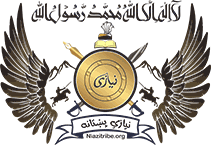







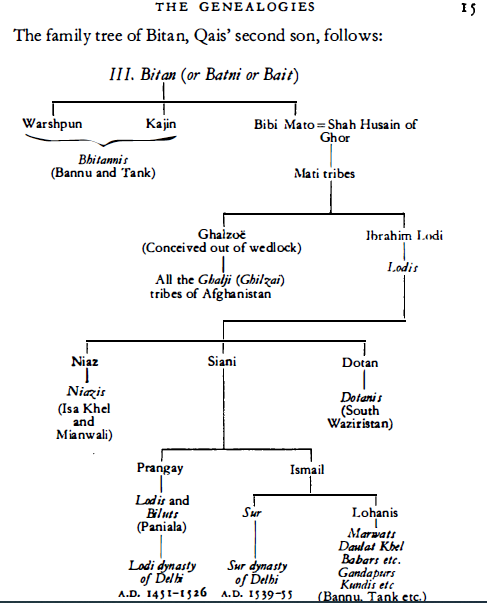
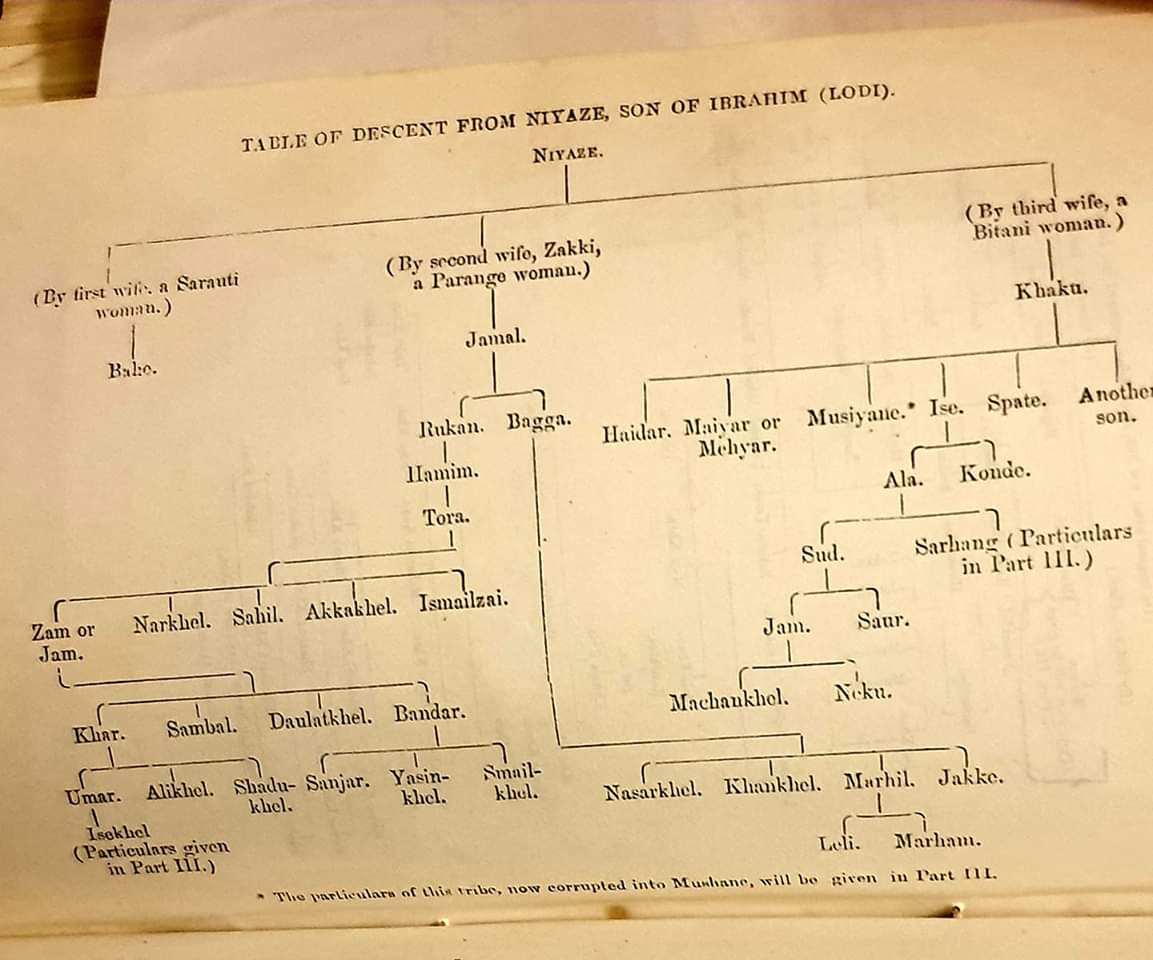
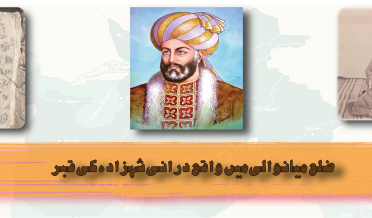
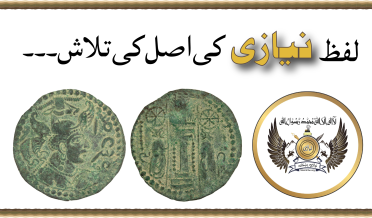
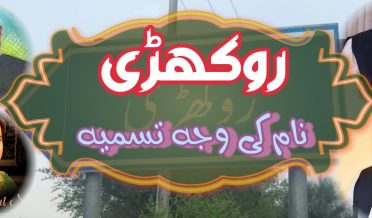
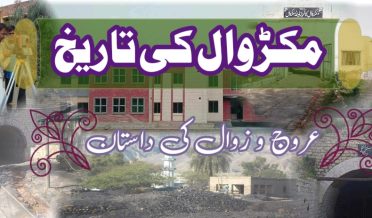


Kiya ap tasdeeq kr sakte pathanSumeen qabeely ki
حال قوم سمین / ثمینڑ
یہ نیازیوں کا ایک ذیلی قبیلہ ہے۔ یہ نیازی کے بیٹے جمال کی اولاد سے ہیں۔ ثمین کی نسل موضع ڈیلی نامدار تحصیل کلورکوٹ ضلع بھکر میں رہاٸیش پزیر ہیں۔ یہاں پر یہ لگ بھگ دو سو سال سے رہ رہے ہیں۔ موجودہ لوگوں کے بزرگ یہاں پنیالہ سے دریاۓ سندھ عبور کر کے آے تھے۔ یہاں تھل کی زمین آباد کی اور یہیں کے ہو گے۔ وقت کے ساتھ پشتو سے سراٸیکی زبان ایسی سیکھی کے اسی کے ہو کر رہ گے۔ اس قبیلہ کا شجرہ بندار بن زام بن تورا بن حمیم بن وگن بن جمال سے ہوتا ہوا نیازے سے جا ملتا ہے۔ سمین قوم موضع کی اکثریتی ملکیتی زمین کی مالک ہے۔ یہ موضع 156,000 کنال پر مشتمل ہے۔
قوم سمین کا مشہور ذیلی قبیلہ خروٹا / اخروٹا / خروٹا خیل ہے۔ جو خود ایک ذیلی قبیلہ ہے نانو خیلوں کا۔ یہاں پر یہ بتانا ضروری ہے کے قوم عیسٰی خیل , سنبل اور سمین نیازی کے بیٹے جمال کی اولاد سے ہیں۔
انعام اللہ خان نیازی
@everyone
یہ درست معلومات نہیں ہیں۔اس طرح کا کوئی ریکارڈ موجود نہیں
Phatan Niazi ka shajra nasaf upload kro
ویب سایٹ پر موجودہے
بہت خوب ماشاء اللہ تبصرہ اور حوالہ افزائی جاری رکھیں
محترم آپ نے نیازی قبیلہ کا شجرہ اپلوڈ کیا بہت شکریہ لیکن شاہ حسین غوری سے اوپر کا شجرہ نسب آپ اپلوڈ کر دیں تاکہ پتہ چل سکے کہ شاہ حسین غوری کون تھا۔۔۔؟؟؟؟